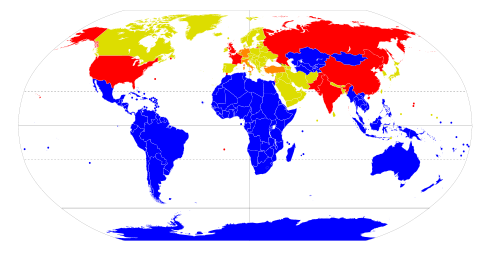
Mongolian Nuclear-Weapons-Free Status
Encyclopedia

President of Mongolia
The President of Mongolia is the head of state of Mongolia. The Constitution of Mongolia implements a parliamentary system, so while much of the President's role is ceremonial, he or she does wield significant political power.-Election:...
Punsalmaagiin Ochirbat announced that his country would seek to become a one-state Nuclear-Weapon-Free Zone (NWFZ). The last Russian troops
Russian Ground Forces
The Russian Ground Forces are the land forces of the Armed Forces of the Russian Federation, formed from parts of the collapsing Soviet Army in 1992. The formation of these forces posed economic challenges after the collapse of the Soviet Union, and required reforms to professionalize the force...
had left the country that same year, and Mongolia
Mongolia
Mongolia is a landlocked country in East and Central Asia. It is bordered by Russia to the north and China to the south, east and west. Although Mongolia does not share a border with Kazakhstan, its western-most point is only from Kazakhstan's eastern tip. Ulan Bator, the capital and largest...
perceived a change in its geopolitical status and an opportunity for neutrality
Neutral country
A neutral power in a particular war is a sovereign state which declares itself to be neutral towards the belligerents. A non-belligerent state does not need to be neutral. The rights and duties of a neutral power are defined in Sections 5 and 13 of the Hague Convention of 1907...
.
The initiative to become a Nuclear-Weapon-Free Zone
Nuclear-Weapon-Free Zone
A nuclear-weapons-free zone, or NWFZ is defined by the United Nations as an agreement which a group of states has freely established by treaty or convention, that bans the use, development, or deployment of nuclear weapons in a given area, that has mechanisms of verification and control to enforce...
was well-received by Mongolia's neighbors, the Russian Federation
Russia
Russia or , officially known as both Russia and the Russian Federation , is a country in northern Eurasia. It is a federal semi-presidential republic, comprising 83 federal subjects...
and the People's Republic of China
People's Republic of China
China , officially the People's Republic of China , is the most populous country in the world, with over 1.3 billion citizens. Located in East Asia, the country covers approximately 9.6 million square kilometres...
(both nuclear weapons states
Nuclear Non-Proliferation Treaty
The Treaty on the Non-Proliferation of Nuclear Weapons, commonly known as the Non-Proliferation Treaty or NPT, is a landmark international treaty whose objective is to prevent the spread of nuclear weapons and weapons technology, to promote cooperation in the peaceful uses of nuclear energy and to...
), as well as by the world community at large, despite being somewhat unorthodox. Previously, NWFZs had been composed of a group of countries, although the possibility of single-state zones had been long recognized. United Nations General Assembly Resolution
United Nations General Assembly Resolution
A United Nations General Assembly Resolution is voted on by all member states of the United Nations in the General Assembly.General Assembly resolutions usually require a simple majority to pass...
3261 F of December 9, 1974, states that "obligations relating to the establishment of nuclear-weapon-free zones may be assumed not only by groups of states, including entire continents or large geographical regions, but also by small groups of States and even individual countries."
Mongolia's drive for international recognition yielded fruit in Resolution 53/77 D http://www.opanal.org/opanal/Documents/UN/53/ing/r53-77d-ing.html, which was adopted by the General Assembly on December 4, 1998, which welcomed Mongolia's goal, and put it on the agenda for the next meeting.
On February 28, 2000, the Mongolian ambassador to the United Nations Jargalsaikhan Enkhsaikhan presented a letter http://www.un.org/documents/ga/docs/55/a5556.pdf outlining the Mongolian de-nuclearization law, which was then circulated as A/55/56 S/2000/160. At this stage, it appears that the international recognition of Mongolia's nuclear-weapons-free status is complete.
During two meetings held in February and in July 2006, particular attention was paid to Mongolia's economic and ecological vulnerabilities and security, and the implementation of General Assembly resolution 59/73.
External links
- The Case For the Single-State Nuclear-Weapon-Free Zone An article produced by the Mongolian mission to the UN.

